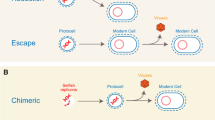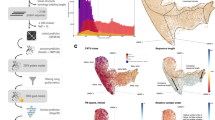Abstract
Biological cells and viruses operate by different replication and symmetry paradigms. Cells are able to replicate independently and express little spatial symmetry; viruses require cells for replication while manifesting high symmetry. The author inquired whether different paradigms were reflected in the permutations of amino acid sequences. The hypothesis was that the permutation structure level and symmetry within viral protein collections exceed that of living cells. The rationale was that one symmetry aspect generally accompanies and promotes others in a system. The inquiry was readily answered given abundant sequence archives for proteins. The analysis of collections from diverse viral and cellular sources lends strong support. Additional insights into protein primary structure, the design of collections, and the role of information are provided as well.








Similar content being viewed by others
Abbreviations
- NCBI:
-
National Center for Biotechnology Information
- BLAST:
-
Basic Local Alignment Search Tool
- UniProt:
-
Universal Protein Resources
References
Chang G, Wang T (2011) Prot J 30:167–172. doi:10.1007/s10930-011-9318-0
Denbigh K (1966) The Principles of Chemical Equilibrium with Applications in Chemistry and Chemical Engineering, chapter eight. Cambridge University Press, Cambridge
Doolittle RF (1981) Science 1981:149–159. doi:10.1126/science.7280687
Dou Y, Geng X, Gao H, Yang J, Zheng X, Wang J (2011) Prot J 30:229–239. doi:10.1007/s10930011-9324-2
Fu X, Gharib SA, Green PS, Aitken ML, Frazer DA, Park DR, Vaisar T, Heinecke JW (2008) J Proteome Res 7:845–854
Glisic S, Veljkovic N, Cupic SJ, Vasiljevic N, Prljic J, Gemovic G, Perovic V, Veljkovic V (2012) Prot J 31:129–136. doi:10.1007/s10930-011-9381-6
Graham DJ, Greminger JL (2009) Mol Divers doi:10.1007/s11030-009-9211-3
Graham DJ, Greminger JL (2011) Mol Divers doi:10.1007/s11030-011-9307-4
Graham DJ, Magdalinos P, Tosi M (1995) J Phys Chem 99:4757–4762. doi:10.1021/j100013a053
Graham DJ, May D, Grzetic S, Zumpf J (2012) Prot J 31:550–563. doi:10.1007/s10930-012-9432-7
Jiang L, Li M, Wen Z, Wang K, Diao Y (2006) Prot J 25:241–249. doi:10.1007/s10930-006-9007-6
Karlin S, Buche P, Brendel V, Altschul SF (1991) Annu Rev Biophys Biophys Chem 20:175–203
Kauffman SA (1993) The origins of order: self-organization and selection in evolution. Oxford University Press, New York
Kirkwood JG (1961) Chemical thermodynamics, chapter nine. McGraw-Hill, NY
Kullback S (1997) Information theory and statistics, Chapter 1. Dover, New York
le Noble WJ (1974) Highlights of organic chemistry, chapter twelve. Dekker, New York
Levy JA, Fraenkel-Conrat H, Owens RA (1994) Virology. Prentice Hall, Englewood Cliffs
Liu H, Yang J, Wang M, Xue L, Chou K-C (2005) Prot J 24:385–389. doi:10.1007/s10930-005-7592-4
Qiu JD, Sun XY, Huang JH, Liang RP (2010) Prot J 29:114–119. doi:10.1007/s10930-010-923-z
Randić M, Lers N, Vukicevic D, Plavšić D, Gute BD, Basak SC (2005) J Proteome Res 4:1347–1352
Randić M, Zupan J, Balaban AT, Dražen V-T, Plavšić D (2011) Chem Rev 111:790–862. doi:10.1021/cr800198j
Savitski MM, Nielsen ML, Kjeldsen F, Zubareve RA (2005) J Proteome Res 4:2348–2354
Song JM, Choi CW, Kwon SO, Compans RW, Kang SM, Kim SI (2011) J Proteome Res 10:3450–3459
Tanford C, Reynolds J (2001) Nature’s robots: a history of proteins. Oxford University Press, Oxford
Tikhonenko AS (1970) Ultrastructure of bacterial viruses. Plenum Press, New York 1970
Wang C, Cheng J, Su S (2009) Prot J 28:111–115. doi:10.1007/s10930-009-9170-7
Wu CH (ed) (2011) Bioinformatics for comparative proteomics. Humana Press, New York
Yu L, Tan Y, Tsai Y, Goodlett DR, Polfer NC (2011) J Proteome Res 10:2409–2416
Acknowledgments
The authors thank Professors Miguel Ballicora and Ken Olsen for discussions about individual proteins and proteomes. The assistance and suggestions of Donald May, John Zumpf, Shelby Grztec, and Julius Aguas are equally appreciated. Thanks are also extended to an anonymous reviewer for criticism and suggestions.
Author information
Authors and Affiliations
Corresponding author
Rights and permissions
About this article
Cite this article
Graham, D.J. A New Bioinformatics Approach to Natural Protein Collections: Permutation Structure Contrasts of Viral and Cellular Systems. Protein J 32, 275–287 (2013). https://doi.org/10.1007/s10930-013-9485-2
Published:
Issue Date:
DOI: https://doi.org/10.1007/s10930-013-9485-2




